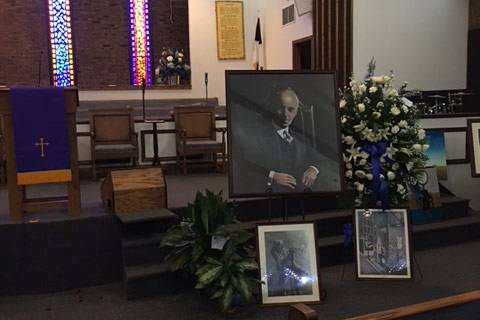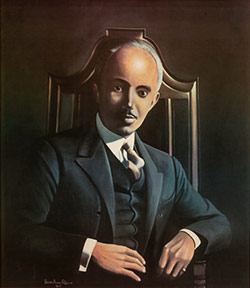Remembering William Pinkney, Painter of Julian Abele's Portrait

North Carolina artist William Alton Pinkney III did many paintings during his long art career, but the one that meant the most to him was the portrait of African-American architect Julian Abele that hangs in Duke University’s Gothic Reading Room.
 Pinkney died this month, and at a funeral service this past weekend in Fayetteville, his surviving family members talked a lot about the Abele painting.
Pinkney died this month, and at a funeral service this past weekend in Fayetteville, his surviving family members talked a lot about the Abele painting.
Benjamin Reese, vice president for institutional equity, represented Duke at Pinkney’s funeral Saturday at Sperring Memorial Baptist Church. Reese spoke at the ceremony and read a letter from President Richard H. Brodhead.
Brodhead's letter said Pinkney's portrait of Julian Abele marked “the beginning of Duke’s uncovering of Mr. Abele’s role, a process that culminated last year in the entire quad being named Abele Quad in his honor. At Duke, we are grateful for your brother’s life and for his powerful contribution toward making Duke’s history visible for all.”
Reese said many people at the service were interested in the Abele painting. “Family members said that Bill believed that this particular painting was the pinnacle of his career. Everyone there had heard of it, but few had seen it at Duke.
“It was quite a moving service in Fayetteville, and everyone was very appreciative that Duke cared about Bill and his contribution to the university,” Reese said.
“That painting meant the world to Bill,” said Colin Pinkney, the artist’s brother. “Bill was the consummate teacher. He always explained in detail the history and context of his work. To him, art wasn’t just something to look at, there was a story and a history to tell and learn about.
“That’s why the Julian Abele painting was so important to him. None of us knew the story of Julian Abele, but when he talked about the painting it was a way of him telling us an important history.”
A native of Fayetteville, William Pinkney moved to the Triangle in the 1970s and had a strong career as an artist around the time that African-American students at Duke rediscovered Abele and the crucial role he played in designing Duke Chapel and other iconic university buildings for the Trumbauer firm in the 1920s.
In 1987, with the approval of then-President H. Keith H. Brodie, the Black Graduate and Professional Student Association initiated the annual Julian Abele Awards and Recognition Banquet. Pinkney was commissioned to paint the Abele portrait, which was unveiled as part of the debut program.
Following the program, the portrait was hung in the foyer of the Allen Building. The original currently hangs in the Gothic Reading Room while a copy remains in Allen Building.
The oil work was a different project for Pinkney, who didn’t do many portraits. He worked off of a photograph of Abele, and as with the photo, Pinkney’s portrait captures the dignity and grace that defined both the man and his architecture.
Vice President Reese invited Colin Pinkney and his family to Duke’s annual MLK Service in Duke Chapel last Sunday, where Phil Freelon, lead architect for the National Museum of African American History and Culture, was keynote speaker. Freelon recognized William Pinkney during his chapel address.
Colin Pinkney said there was much about the Duke MLK service that reminded him of his brother. “Listening to Phil Freelon discuss his work reminded me of how Bill would talk about his art,” Pinkney said. “And when his wife Nnenna sang, jazz was there. Whenever Bill painted there was jazz music in the background. It was a beautiful service.”